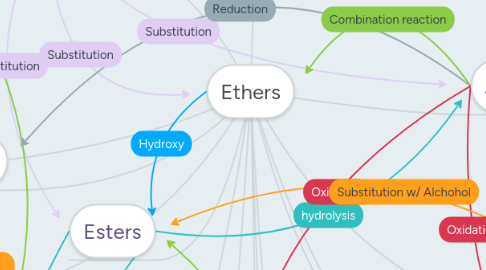Ethers
por Rhealyn Diosana


1. Esters
2. Alkyl Halides
3. Alkene
4. Ketones
5. Amine
5.1. Tertiary
5.1.1. Only three organic substituent is connected to Nitrogen
5.2. Secondary
5.2.1. Only two organic substituent is connected to Nitrogen
5.3. Primary
5.3.1. Only one organic substituent is connected to the Nitrogen
5.4. Reacts with Keytones and Aldehydes to produce reaction product to dehydrate aldimines and ketimines
5.5. Oxidation
5.5.1. All Amines can be oxidized
5.5.2. Only Teriery Amines can form amine oxides
5.6. Halogenation
5.6.1. Form of Alkylation
6. Alkyne
7. Alkane
7.1. Halogenation
7.1.1. makes alkyl halides, haloalkanes, Hydrogen halide
7.2. Combustion/oxidation
7.2.1. makes aldehydes, acids
8. B-ketoester
9. Soaps
10. Alcohols
10.1. Oxidation
10.1.1. primary Alcohols --> Aldehydes
10.1.1.1. Oxidizeds to Carboxylic acids
10.1.2. Secondary Alcohols --> Ketones
10.1.3. Tertiary Alcohols --> no rxn
10.2. Subsitution
10.2.1. Haloalkane
10.3. Reduction
10.3.1. Alkene
11. Carboxylic Acids
11.1. React with alcohol
11.1.1. Ester
11.2. React with ammonium salt then heat
11.2.1. Amides
11.3. react with PCl5 or SOCl2 in the presence of a base
11.3.1. Acid Halides
11.4. reacts CA salt with acyl halide to
11.4.1. Acid Anhydrides
11.5. Reduction
11.5.1. Aldehydes
12. Aldehyde
13. Amides
13.1. Reduction of Amide to Primary Amine
13.2. Hydrolysis; amide forms parent carboxylic acid and parent amine molecules.
13.2.1. Carboxylic Acid
13.3. Dehydration; amide forms water and a nitrile compound.
13.3.1. Nitrile
13.4. Esterification; substitution reaction with an alcohol to form an ester and amine
13.4.1. Ester
